The Peril of Alma Bridge Road
Brian Phan reports on thousands of dead California Newts (Taricha torosa) are counted every year by citizen scientists. Will the local government take action to stop the massacre? Illustrations by Kristen Burroughs and Connie Speer.
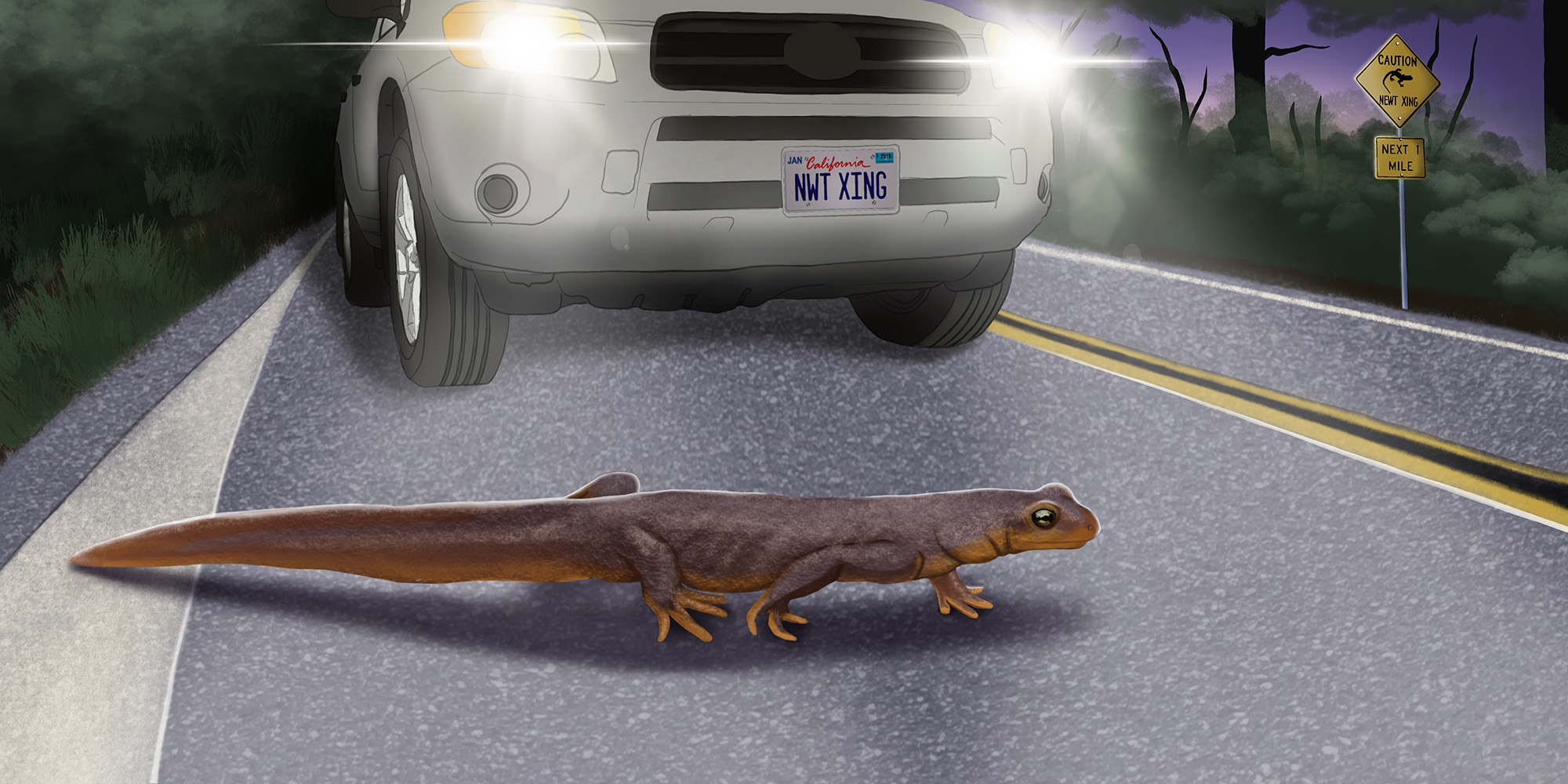
Illustration: Kristen Burroughs
On a cold January morning in central California, Merav Vonshak is bundled up in a neon yellow vest with a picture of a California newt and “Newt Patrol” written on the back. Vonshak takes out her phone, a sheet of laminated paper with columns of local animal footprints and along the side a ruler, and a small pocket knife. She’s ready to take a four-mile walk on one of the deadliest roads for animals in the world, here in the Santa Cruz mountains.
A few feet from her car on Alma Bridge Road, Vonshak scrapes a dried, flattened newt off the road. As she peels the newt off the pavement, it makes a sound like the unwrapping of a fresh Fruit Roll-Up. Vonshak throws the newt off the road so that it does not get recorded twice.
“It’s not glamorous work, and I don’t love dead things, but it has to be done,” said Vonshak, an ecologist who runs the citizen scientist group Newt Patrol. She has made it her life’s mission to document the devastation of newts along this stretch of road.
The Alma Bridge Road surrounds Lexington Reservoir, a 338 acre human-made reservoir on Highway 17 Santa Clara County. Visitors to the reservoir enjoy nature through hiking trails, fishing, and boating. But the road is deadly for newts.
Every year between November and May, newts migrate from the nearby forest to the reservoir to breed. To get to the reservoir, they must cross the twisting Alma Bridge Road. Citizen scientists have recorded up to 5,000 dead newts per year on the road for the last five years. This year, newt deaths hit a record high, with over 8,200 dead newts. All of this makes the road one of the most recorded lethal roads for amphibians anywhere in the world. Vonshak and many members of the public are urging government agencies that manage the road to make it safer for newts.
So far, local agencies have done little to protect the newts. One action that agencies have done in the past couple of years has been trying to inform the public of the crossing of the newts, through website information pages, informational signs at the reservoir to “CAUTION NEWT XING” signs at hotspots. But these actions have not helped in slowing down the massacre.
Local officials of Santa Clara County said it would build tunnels and fences to corral the newts before the next winter season of 2022-23. But they have not explained where or when they will build these measures.
Without immediate action, scientists predict that local extinction could happen in 57 years and the local newt population will plummet to less than 1,000 individuals in ten years.
Watching a California newt creep across a trail between November and March in the mountains of California, an observer can’t help but stand still in wonder as you gaze into the little amphibian’s face. California newts have dark, grainy skin on their backs and a bright orange underbelly that warns predators that this animal is poisonous. The newt might glance up with an amphibian eyes before continuing on with one thing on its mind.
California newts breed in slow flowing streams and ponds. During the warmer months, newts live in burrows that were made by badgers, ground squirrels, and other digging animals to find enough moisture deep underground. When the rain comes, these newts come out of the ground like zombies from a stasis that has kept them solitary and separated from each other. In pursuit of breeding, they embark on a treacherous journey downhill across roads to mate.
This is where the danger starts and not just in Santa Clara County. In the Bay Area, like Petaluma, California newts are crossing roads and are being killed there as they cross the road for love. When heavy rain pours, volunteers from Chileno Valley Newt Brigade emerge from their homes to assist the newts by carrying them across Chileno Valley Road, another deadly road.
A newt’s life
Have you ever seen a ball of newts rolling down the stream by the dozens? I haven’t but researchers have counted up to 50 newts all huddled together rolling down stream and in the center of it all, a female surrounded by males. This is the newt ball.
The females produce a strong pheromone that makes the boys go crazy. This causes them to surround the female and fight for the right to be next to her by grappling against other males and with the female. When the female is ready she will unload her eggs upon vegetation, where the males will then release their sperm.
California newts have a high site fidelity, returning to the same breeding sites over and over again, similar to people revisiting their favorite restaurants.
Newts will rather breed in bodies of water that do not contain any predators for the safety of their babies.
Baby newts look like miniature forms of the adults and many animals eat them, including largemouth bass, crayfish, and even some adult newts that stay in their aquatic form for the purpose of cannibalism.
After the weather warms up in spring the newts must go back uphill to their burrows to live in the hills again. But these hills are hundreds of feet back up the hills of the local mountain range and the newts have to cross the same dangerous road a second time.
The beginning of recording the end
Back on the road near Lexington Reservoir, Vonshak has walked about a mile from her car. The road divides two different worlds. One side, fishermen cast lures from the banks of the reservoir with the occasional row boat passing by. On the other side lies a steep forest with the occasional fence or gate leading to a residential home. Vonshak and a volunteer walk down the road chatting, but their conversations are often cut off by speeding vehicles. The first person to spot the threat shouts “CAR!”, sending the two scurrying to safety at the side of the road.
Vonshak estimates that she’ll count 200 dead newts today. That’s better than a few weeks earlier, when a downpour brought the newts rushing out of their burrows. Vonshak counted more than 600 dead newts on a one mile stretch of the road that day and could not finish by herself because it was too much after 4 hours. She and another volunteer had to come the next day to finish the stretch of road.
In 2017, Vonshak started organizing BioBlitz events in the Bay Area that organize citizen science events to explore the diversity in local parks around the Bay Area. She later created the website Bioblitz.club, through which she is organizing her outreach events.
Vonshak earned her PhD in ecology from Tel Aviv University in Israel. She then moved on to a postdoctoral studies at Stanford University. There, she met a friend, a biologist and retired software engineer, Anne Parsons. Parsons started to collect data on the demise of the newts in 2017. Parsons asked Vonshak to help out with the data collection; eventually, Vonshak took over the project from Parsons.
Vonshak and citizen science volunteers have been surveying this stretch of road for four years, documenting the tragic demise of over 23,000 newts so far. She and her team of “Newt Patrol” volunteers come out at least once a week during the migration season. They walk in pairs down the road, with Vonshak taking one half of the road and with the volunteer taking the other.
When they encounter something that might be a newt on the asphalt, they first have to identify it. After a few days on the road, the newts are unrecognizable, and just look like a dark stain on the road. They can be confused for crushed wet leaves or insects.
Once they confirm that they have found a roadkill newt, they upload its picture to the iNaturalist database. Finally, they use a small knife or a paint scraper to remove the newt and throw it off the road so that they don’t double-count it.
Vonshak knows that her team is missing many dead newts, because they only have enough volunteer labor to patrol once a week. In 2020, for instance, Vonshak did an experiment while on patrol. She and her team used flags to mark the side of the road near each dead newt. Four hours later, Vonshak found that 25% of the newts had been moved or had disappeared; in 24 hours 60% of the newts were gone.
A study commissioned by local government agencies has confirmed Vonshak’s observations that traffic is taking a deadly toll on newts. In November 2020, the agencies that own the land around the road, Peninsula Open Space Trust and MidPeninsula Open Space, paid for a study on how roadkill is affecting this population around the reservoir of newts.
Jeff Wilkinson, the herpetologist who conducted the study for a private firm, HT Harvey & Associates, estimated that close to 14,000 adult newts crossed the road in a span of five months from November to March in 2020-21. Wilkinson further estimated that if the high rate of roadkill loss continues, the population of breeding adults near Lexington Reservoir will crash to under 1,000 individuals in 15 years from now and the local population of newts will go extinct in 57 years.
Vonshak says the study adds urgency to her findings. “The data we collect shows how large-scale this massacre is happening,” Vonshak says.
“The data we collect shows how large-scale this massacre is happening.”
The data is, indeed, so disturbing that some iNaturalist users have tried to discourage her Newt Patrol work.
Vonshak recalls that one user asked, “Why keep on collecting the data? We know that they are dying. Do you guys just like dead things? Why don’t you help them move from one side to the other?”
“I would help them if I saw them,” said Vonshak. “I only see a few live newts, out of thousands of dead ones.”
This last newt season, Vonshak personally documented over 4,200 dead newts and only six live ones. In the rare case she finds a live one, she picks it up and helps it cross the road.
Even with some doubts in the community, Vonshak still walks the four to eight miles a week in the name of science and hoping to save these newts.
Public outcry
Vonshak and members of the public have mobilized to try to stop the massacre through vocalizing their concerns. At a public meeting in December 2021, more than 100 people urged Midpeninsula Regional Open Space District, Midpen, to take steps to protect the newts. Midpen has jurisdiction over the reservoir and the surrounding preserve area.
Deluged by public outcry at the meeting, one Midpen director, Pete Siemens, questioned whether every comment should be spoken out loud. “Do we need to read all those letters?” Siemens said. “Or could we have them posted on the website?”
But the board decided to allow every public commenter to be addressed in the meeting. Many, alarmed by newt deaths, pleaded with officials to save them. For instance, said Howard Cohen from Palo Alto:
“The high levels of mortality on Alma Bridge Road is exacerbated by climate change and can drive our newt population to extinction. We have no time to lose.”
Citizens and scientists have urged Midpen and other agencies to consider measures such as creating tunnels underneath the road to help in channeling the newts in hotspots, creating lifted roadways where a platform is installed where the newts could walk under, assisted migration, and closing the road. But agencies are reluctant to build tunnels or lifted roadways, because heavy-duty construction vehicles use the road to access a local quarry.
“Building raised roadways for newts is going to be very expensive. Unless you can have a raised road that can support thousands of pounds constantly, then it’s not going to work,” said Harry Freitas, the director of the roads and airports department for the County of Santa Clara.
But in 2021 the county of Santa Clara, which has jurisdiction over the road, gave its first indication that it would consider other measures to protect newts. The county said it will build tunnels and fences to corral the newts before winter 2022-23.
“We don’t want newts to be killed on our road, and we can clearly see that the public cares a great deal about this issue,” said Freitas.
“We don’t want newts to be killed on our road, and we can clearly see that the public cares a great deal about this issue.”
So far, the county hasn’t released plans for where the tunnels and fences will be built. But Vonshak says this could be a step in the right direction. She thinks that Wilkinson’s study on how roadkill could lead to local newt extinction has convinced government agencies to act.
“We are working together,” said Vonshak. Vonshak has been hired from a consultant company that is working closely with the county on designing and building crossing structures for the newts.
Still, she’s worried but hopeful about whether the county’s plans will go far enough to save the newts. Other critics say Midpen and the county must move faster.
“It’s a constantly unfolding tragedy on that one road. And it’s symbolic of how we treat nature” said Fraser Shilling, director of the University of California Davis, Road Ecology Center, the center that has deemed this road as the most dangerous road in the world for animals. “We’ve been flagging this for years.”
“We need to make a change”
One cozy evening, I visited one of the newt mortality hotspots. As I parked near the reservoir on a dirt turnout by an entrance to one of the area’s more traveled hiking trails, I could hear distant bird songs as the sun began to set along the mountain tops. Though multiple cars were parked nearby, I breathed a sigh of relief as I thankfully didn’t find any dead newts on the road.
I strolled down a path to the reservoir, not knowing what I would see. When I got to the water, I couldn’t believe my eyes. There were newts everywhere—multiple newt balls of three to ten newts breeding in crystal clear water. In a small area, 20 ft across, I saw close to 70 newts. Chuckling, I smiled as I watched these little critters doing their thing.
I could see why this area was considered a hotspot of newt mortality with all the newts that were breeding in the water.
After spending weeks reporting on newt death, I was so happy to see that these newts had successfully crossed the road and were preparing to make the next generation of newts that call these hills home.
When I got to my car, I decided to glance over my shoulder at the road. My heart dropped. A total of 15 minutes had passed since I’d gone down to the water. I couldn’t believe my eyes. There, in the middle of the road, was a California newt that had just been run over. It was still moving, mortally wounded. As I approached, the newt twitched, then stopped moving and was still.
“We need to make a change,” said Shilling. “If we can’t take a stand or a difference here—where large numbers of animals are dying every year, and the problem is easily avoidable—then it will be sad for ecology and conservation.”
© 2022 Brian Phan / UC Santa Cruz Science Communication Program

Brian Phan
Author
B.S. Biology, California State University, Monterey Bay
Internships: Monterey Herald, Santa Cruz Local, Seymour Center
Every day after elementary school, I soaked up the enthusiasm Steve Irwin exuded, imagining myself experiencing wildlife with him. Irwin’s TV show, “The Crocodile Hunter” was my window to nature growing up.
Decades later, I carried Steve’s passion to each tour that I led as a shipboard naturalist on the Monterey Bay. I saw my childhood self in audience members whose eyes grew wide when I shared information about the animals we saw, such as the fact that blue whales slow their heart to four beats per minute during deep dives. By sharing these scientific scoops—in person and via a growing Instagram account—I realized my passion for communicating science.
With every photo and every word, I want to bring you on an adventure into the natural world. I want to make you feel as though we’re experiencing nature together—just as I did with Steve Irwin when I was young.
Instagram: @phantastic_tides
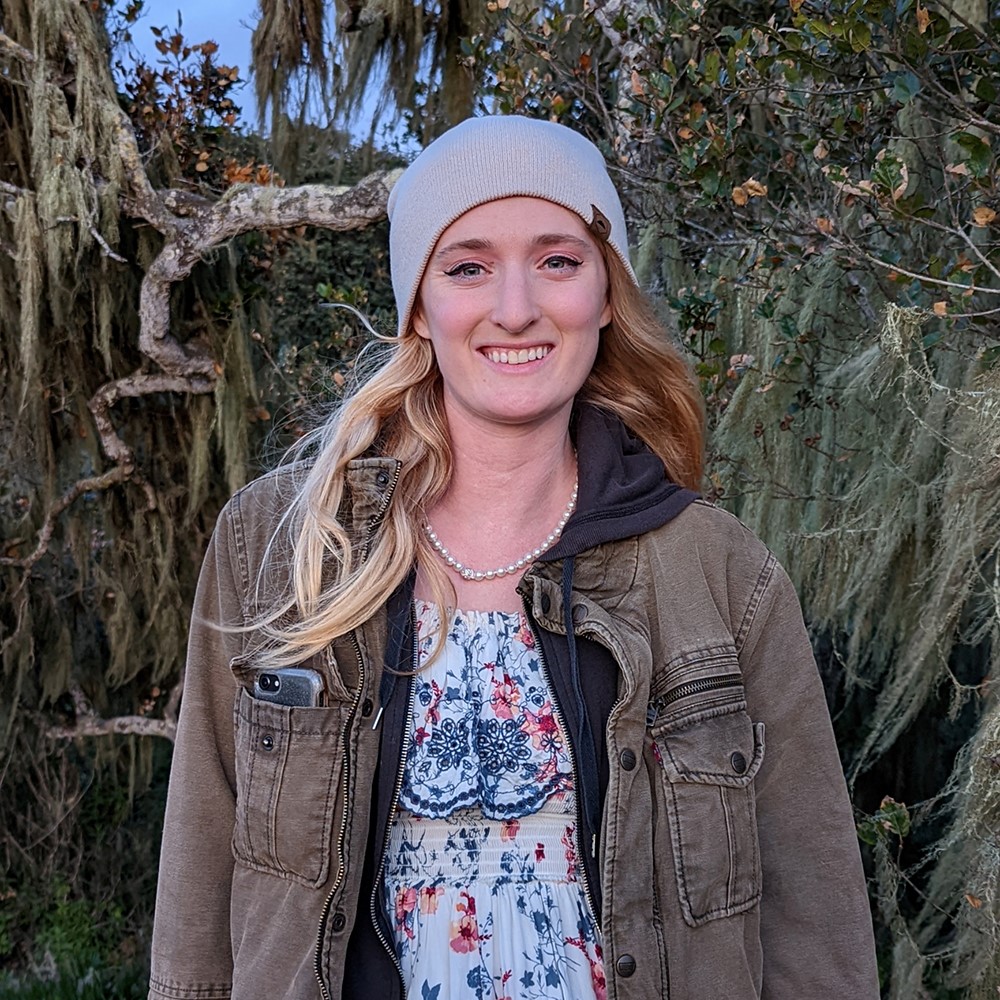
Kristen Burroughs
Illustrator
A southern California native, Kristen moved North to Monterey County to study marine science, and received her B.S. in 2015 from California State University, Monterey Bay. Only after working hands-on with animals for many years did she learn about the possibility of becoming a science illustrator. She decided she wanted to apply for the science illustration program at CSUMB, so she enrolled in a variety of art classes and taught herself basic digital art so that she could create a portfolio and apply to the program. She got in, and loves to illustrate animals, especially bats and owls! Kristen hopes to promote conservation for wildlife with her artwork. Her upcoming science illustration internship will be creating bat content for Bat Conservation International. In her free time, she enjoys birdwatching, nature photography and working in her garden.
www.kristenburroughsillustration.com
Instagram: @hellohsparroh
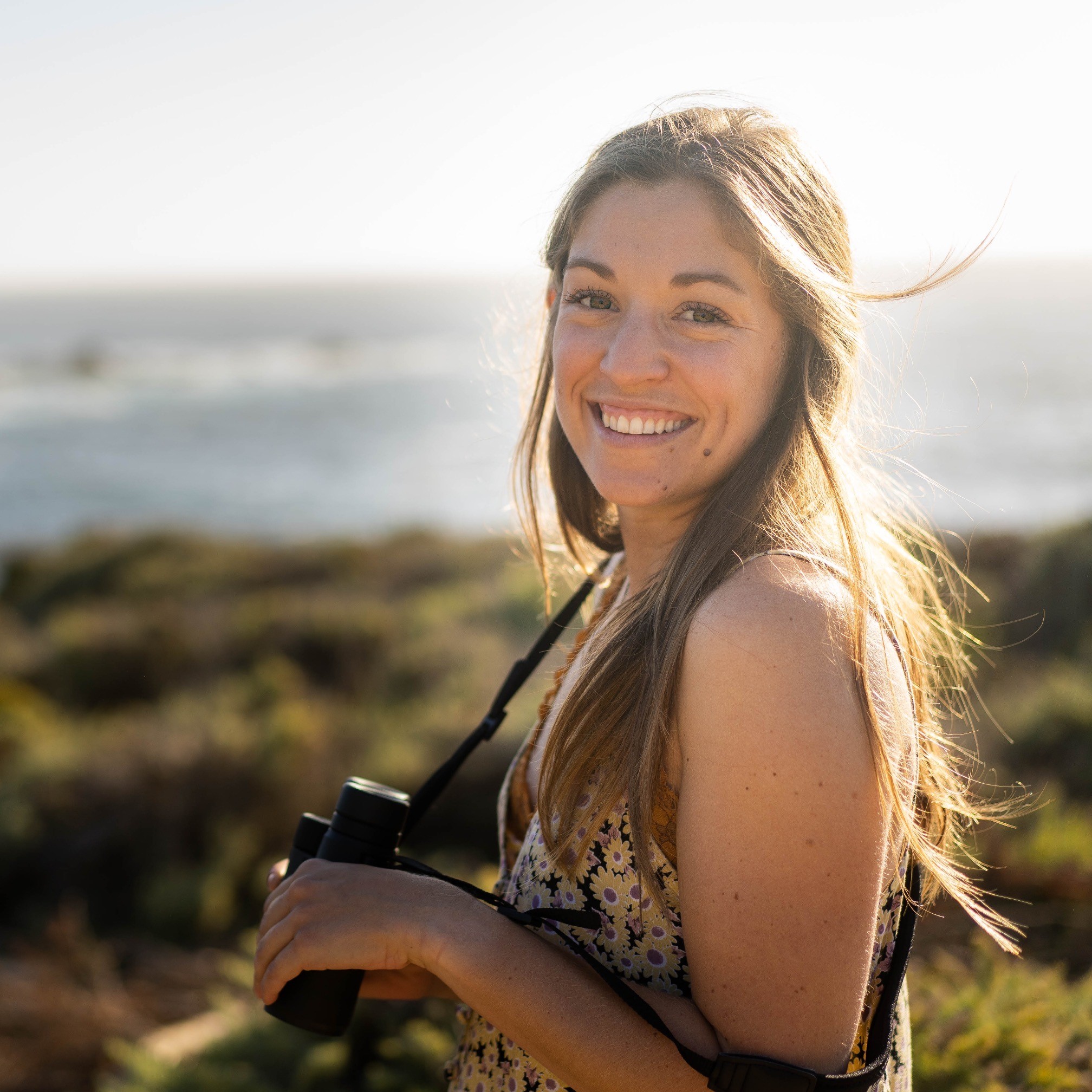
Connie Speer
Illustrator
In a fast paced culture, it is easy to miss the beauty surrounding us. Illustrating the natural
world allows me to witness intricacies which normally go unnoticed. Art has always been a
strong part of my identity, along with a strong love for the outdoors. Growing up in San
Diego, I was fortunate enough to enjoy most of my childhood by the water. Long days were
spent being tackled by waves and drying off in the sun. Evenings were finished drawing
animals and fictional creatures. When I chose my college for undergrad, it was important to
me to stay by the ocean. It was equally necessary for me to study visual art. CSUMB was the
perfect fit. While attending CSUMB I discovered the Science Illustration program through
summer classes. Learning about a career which combines my love for art and the natural
world, allowed my passions to finally connect. Science Illustration enables me to depict the
intricacy of the Natural Sciences with others through visual breakdowns. The more I study
Science Illustration, the more vibrant and curious the natural world becomes. I hope my
illustrations serve as a reminder of the beauty found in moments of tranquil observation.
https://www.conniespeerillustrations.com/
Instagram: @constance_acrylic
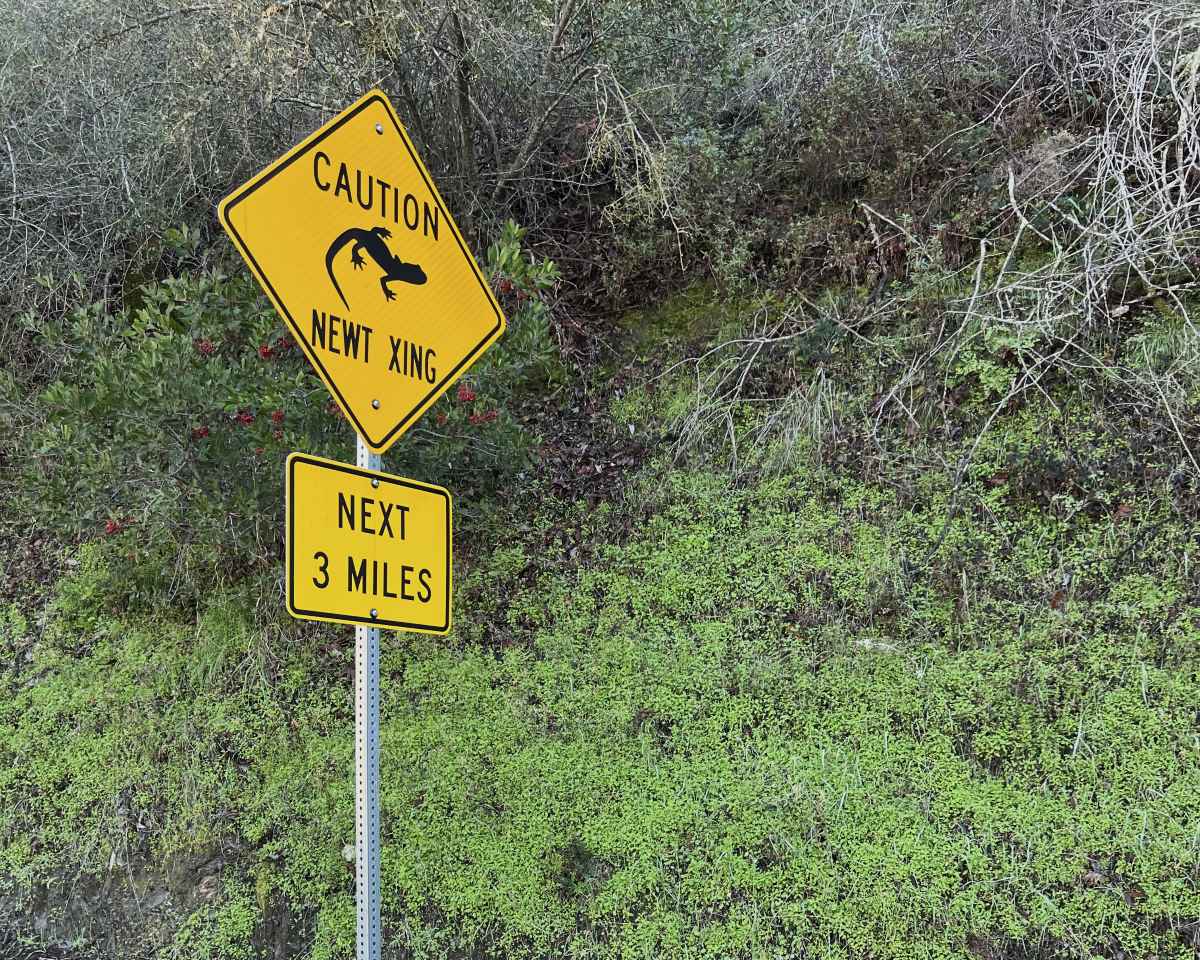
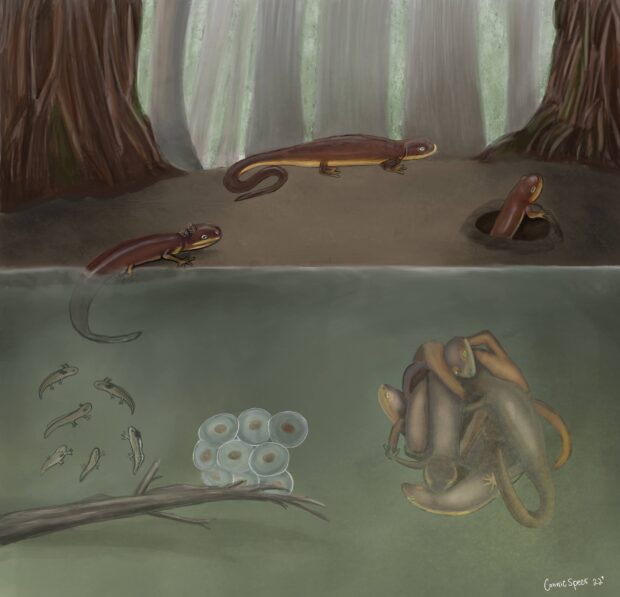
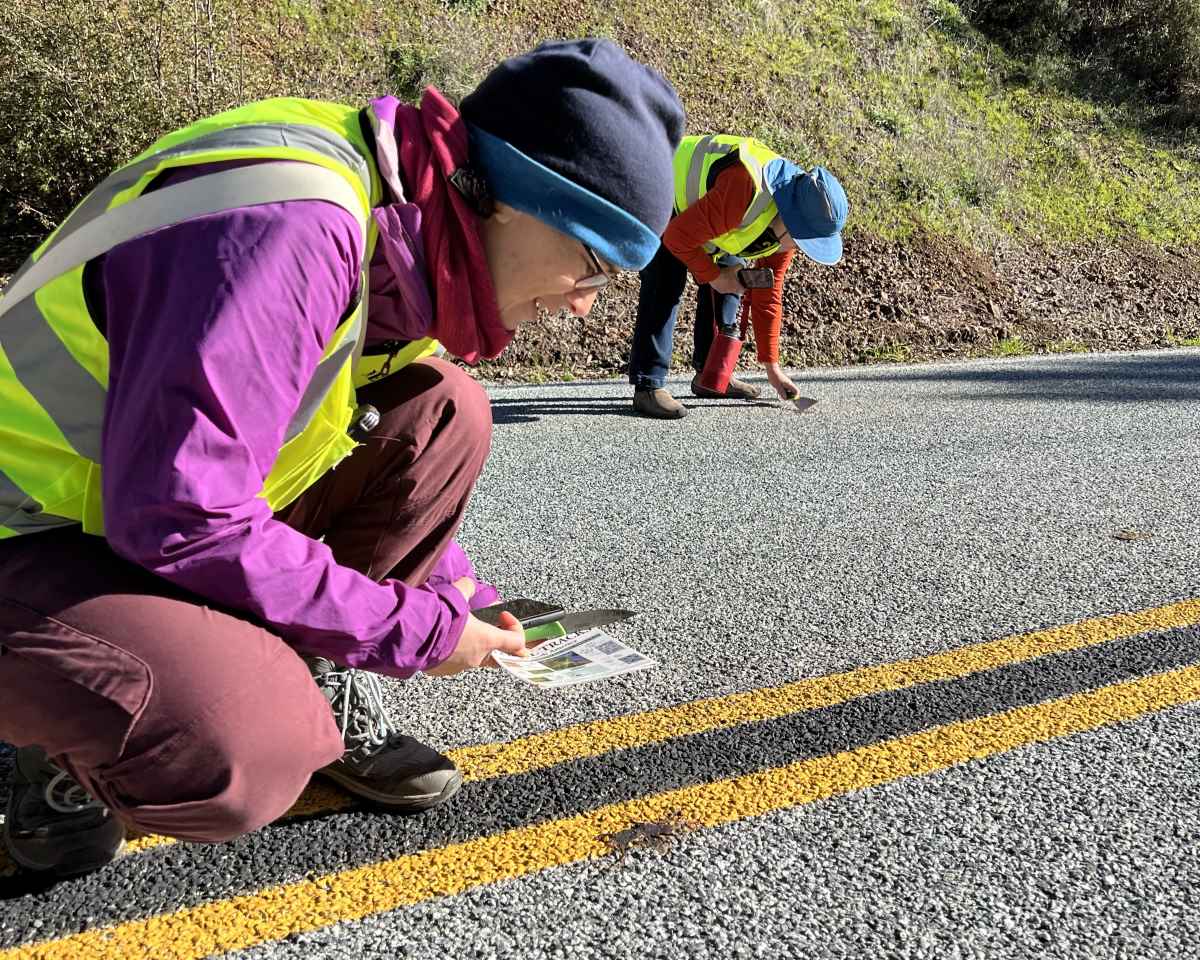
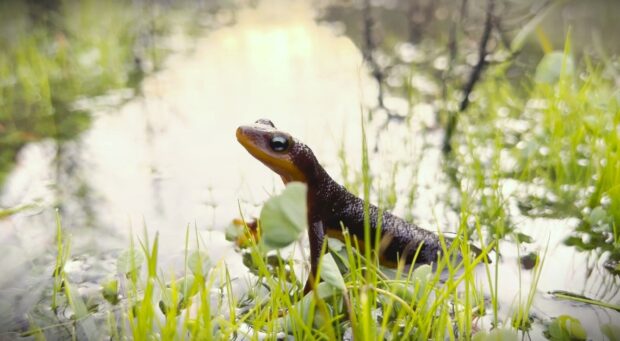
PathFind IR 11 has the action for drivers to see the seen and the unseen at day or night. Children, People and animals big or small can be seen by drivers 450’ ahead. Teledyne FLIR has the technology is the Sustainable Mobility for all road user for safer travel on our roads.
FLIR has the PathFind IR II, Thermal Imaging Technology, the World Sixth Sense.
Watch in total darkness
Automatic detection and alerts of people and Creatures at night
You can see pedestrians and vehicles past approaching headlights.
You can see many uncertainties four times further off than with headlights.
You can look through the dust and smoke.
Have more time to acknowledge
Every year the lives of approximately 1.3 million people are cut short as a result of a road traffic crash. Between 20 and 50 million more people suffer non-fatal injuries, with many incurring a disability as a result of their injury. the United States, over 1 million vertebrate animals are killed by vehicle collisions every day. Globally, the number amounts to roughly 5.5 million killed per day, which when extrapolated climbs to over 2 billion.
Leaders of the World, Governments, Insurance Companies and auto industry need to act on road accidents. Killing people and making some animals extinct. Teledyne FLIR, have made PathFind IR 11, Thermal Imaging Technology, the World Sixth sense. A Driver’s Vision Enhancement System for Today’s Vehicles.
To save lives, the World needs to make PathFindIR 11 mandatory and lawful in all vehicles to prepare, motorists to see and stop, and not hurt or killing children, people and animals on the roads, saving life, damages, and lot of money.
The world should demand to make it mandatory for PathFindIR 11 to be law and in all vehicles. Data shows that 80% of accidents caused by human errors. Having PathFindIR 11 will help drivers to see 450’ ahead and prepare, to stop, and not hurt or kill people and animals on the road, saving life’s and damages. In America collisions between motorists and wildlife cause more than $8 billion . Show we care, stop the killing on roads around the World.